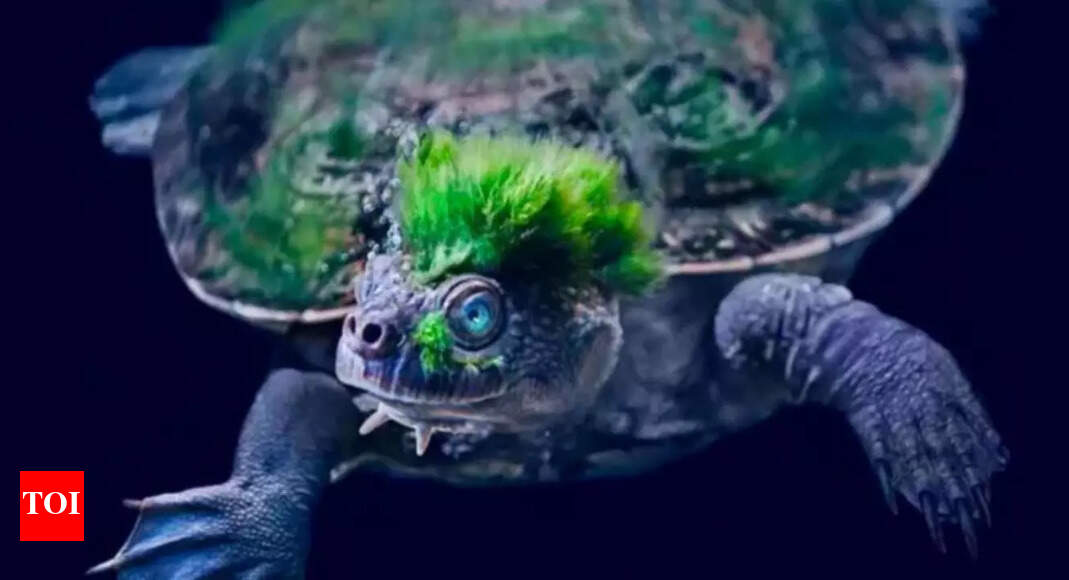 Source: Jerry Coleby-Williams Australia is renowned for its unique and diverse wildlife, from kangaroos to platypuses. Among its most extraordinary creatures is the Mary River Turtle, a freshwater species native to Queensland that has captivated scientists worldwide. This turtle has evolved remarkable adaptations to survive in the challenging river ecosystems it inhabits. Its most striking feature is its ability to breathe through its rear, allowing it to remain submerged for extended periods while conserving energy and avoiding predators. This unusual biological trait, combined with its distinctive appearance and stealthy behaviour, makes the Mary River Turtle one of the most fascinating reptiles in the world. Its existence highlights both the wonder of evolution and the importance of conserving Australia’s fragile aquatic habitats.
Source: Jerry Coleby-Williams Australia is renowned for its unique and diverse wildlife, from kangaroos to platypuses. Among its most extraordinary creatures is the Mary River Turtle, a freshwater species native to Queensland that has captivated scientists worldwide. This turtle has evolved remarkable adaptations to survive in the challenging river ecosystems it inhabits. Its most striking feature is its ability to breathe through its rear, allowing it to remain submerged for extended periods while conserving energy and avoiding predators. This unusual biological trait, combined with its distinctive appearance and stealthy behaviour, makes the Mary River Turtle one of the most fascinating reptiles in the world. Its existence highlights both the wonder of evolution and the importance of conserving Australia’s fragile aquatic habitats.
How the Mary River turtle survives underwater for hours
The Mary River Turtle (Elusor macrurus) is a freshwater species found exclusively in the Mary River system of Queensland. Its combination of unusual behaviours, striking appearance, and rare biological adaptations makes it one of Australia’s most intriguing reptiles. Unlike other turtles, it has developed specialised survival strategies to thrive in slow-moving river habitats, making it a unique symbol of evolutionary ingenuity. The most astonishing adaptation of the Mary River Turtle is its ability to perform cloacal respiration. While most turtles rely solely on their lungs to breathe air, this species can extract oxygen directly from water through its cloaca, an opening near its rear. Tiny sacs inside the cloaca absorb dissolved oxygen from water, allowing the turtle to remain submerged for exceptionally long periods.This adaptation is particularly advantageous in its slow-moving river habitat. By staying underwater, the turtle can hide from predators, conserve energy, and hunt without revealing its presence. Depending on water temperature and activity levels, the Mary River Turtle can remain submerged for up to 72 hours without surfacing. This remarkable trait has earned it the nickname “bum-breathing turtle” and highlights the extraordinary ways animals adapt to their environments.
Survival advantages of cloacal respiration in the Mary River turtle
Cloacal respiration provides the Mary River Turtle with a critical survival edge. By remaining hidden underwater, it can avoid predators such as birds, crocodiles, and large fish. This energy-efficient method of oxygen intake allows the turtle to remain still for hours, waiting for prey or avoiding detection. In the slow-flowing rivers it inhabits, this ability is crucial for both survival and foraging, especially during dry seasons or when oxygen levels drop.The capacity to stay submerged also reduces stress and energy expenditure, allowing the turtle to thrive in habitats where oxygen levels may fluctuate and predation risks are high. Such remarkable adaptations underscore the turtle’s exceptional evolutionary niche and resilience among freshwater reptiles, highlighting its importance in aquatic ecosystems.
Unique appearance and remarkable agility of the Mary River turtle
The Mary River Turtle is not only biologically remarkable but visually distinctive. Algae often grows on its head, forming a green mohawk-like pattern. While this may appear unusual, it serves as highly effective camouflage, blending seamlessly with the river environment. This natural “punk hairstyle” helps the turtle avoid predators while adding to its reputation as one of nature’s most visually intriguing reptiles.Despite its ability to remain still underwater for long periods, the Mary River Turtle is a surprisingly agile swimmer. It prefers calm or slow-moving waters but can move quickly when threatened or when hunting prey. This combination of stealth and speed enables the turtle to conserve energy while still being capable of rapid action when necessary. Its behaviour demonstrates a balance between endurance, survival, and adaptability in aquatic ecosystems.
Diet, foraging behaviour, and reproductive challenges of the Mary River turtle
The Mary River Turtle is omnivorous, feeding on a diet of aquatic plants, small invertebrates, and carrion. Its feeding habits are closely tied to its environment, relying on camouflage and stealth to capture prey efficiently. The turtle’s prolonged underwater endurance allows it to forage without frequent surfacing, reducing exposure to predators and increasing its chances of survival in competitive river habitats.Reproduction in the Mary River Turtle is relatively slow, contributing to its vulnerability as a species. Female turtles lay eggs in riverbanks, which hatch after an extended incubation period. Juveniles are particularly susceptible to predation, while adults must contend with environmental challenges such as habitat degradation and water pollution. Understanding its reproductive behaviour is essential for conservation planning and ensuring the species’ long-term survival.
Endangered status and conservation efforts for the Mary River turtle
The Mary River Turtle is classified as an endangered species. Its population has been significantly reduced due to habitat destruction, poor water quality, and historical over-collection for the exotic pet trade during the 1960s and 1970s. River modification, agricultural runoff, and climate change continue to threaten the delicate ecosystem it depends on. Without urgent conservation measures, the species faces the risk of further decline or potential extinction.Conservation initiatives in Australia focus on protecting the Mary River Turtle and its habitat. Key measures include habitat restoration, captive breeding programmes, and monitoring of water quality. Wildlife organisations and researchers work to rehabilitate the Mary River ecosystem, ensuring that turtle populations have a sustainable environment to thrive in. Public education and awareness campaigns also play a critical role in safeguarding this remarkable species for future generations.

